Configure the ASA for Redundant or Backup ISP Links
Available Languages
Download Options
Bias-Free Language
The documentation set for this product strives to use bias-free language. For the purposes of this documentation set, bias-free is defined as language that does not imply discrimination based on age, disability, gender, racial identity, ethnic identity, sexual orientation, socioeconomic status, and intersectionality. Exceptions may be present in the documentation due to language that is hardcoded in the user interfaces of the product software, language used based on RFP documentation, or language that is used by a referenced third-party product. Learn more about how Cisco is using Inclusive Language.
Contents
Introduction
This document describes how to configure the Cisco ASA 5500 Series static route tracking feature to use redundant or backup Internet connections.
Prerequisites
Requirements
There are no specific requirements for this document.
Components Used
The information in this document is based on these software and hardware versions:
- Cisco ASA 5555-X Series that runs software Version 9.x or later
- Cisco ASDM Version 7.x or later
The information in this document was created from the devices in a specific lab environment. All of the devices used in this document started with a cleared (default) configuration. If your network is live, ensure that you understand the potential impact of any command.
Related Products
You can also use this configuration with the Cisco ASA 5500 Series Version 9.1(5).
Note: The backup interface command is required in order to configure the fourth interface on the ASA 5505 Series. Refer to the backup interface section of the Cisco Security Appliance Command Reference, Version 7.2 for more information.
Background Information
This section provides an overview of the static route tracking feature that is described in this document, as well as some important recommendations before you begin.
Static Route Tracking Feature Overview
One problem with the use of static routes is that no inherent mechanism exists that can determine whether the route is up or down.
The route remains in the routing table even if the next hop gateway becomes unavailable.
Static routes are removed from the routing table only if the associated interface on the security appliance goes down.
In order to solve this problem, a static route tracking feature is used in order to track the availability of a static route.
The feature removes the static route from the routing table and replaces it with a backup route upon failure.
Static route tracking allows the ASA to use an inexpensive connection to a secondary ISP in the event that the primary leased line becomes unavailable.
In order to achieve this redundancy, the ASA associates a static route with a monitoring target that you define.
The Service Level Agreement (SLA) operation monitors the target with periodic ICMP echo requests.
If an echo reply is not received, then the object is considered down, and the associated route is removed from the routing table.
A previously configured backup route is used in place of the route that is removed.
While the backup route is in use, the SLA monitor operation continues its attempts to reach the monitoring target.
Once the target is available again, the first route is replaced in the routing table, and the backup route is removed.
In the example that is used in this document, the ASA maintains two connections to the Internet.
The first connection is a high speed leased line that is accessed through a router provided by the primary ISP.
The second connection is a lower speed Digital Subscriber Line (DSL) that is accessed through a DSL modem provided by the secondary ISP.
Note: The configuration that is described in this document cannot be used for load balancing or load sharing, as it is not supported on the ASA. Use this configuration for redundancy or backup purposes only. Outbound traffic uses the primary ISP, and then the secondary ISP if the primary fails. Failure of the primary ISP causes a temporary disruption of traffic.
The DSL connection is idle as long as the leased line is active and the primary ISP gateway is reachable.
However, if the connection to the primary ISP goes down, the ASA changes the routing table in order to direct traffic to the DSL connection.
Static route tracking is used in order to achieve this redundancy.
The ASA is configured with a static route that directs all of the Internet traffic to the primary ISP.
Every ten seconds, the SLA monitor process checks in order to confirm that the primary ISP gateway is reachable.
If the SLA monitor process determines that the primary ISP gateway is not reachable, the static route that directs traffic to that interface is removed from the routing table.
In order to replace that static route, an alternate static route that directs traffic to the secondary ISP is installed.
This alternate static route directs traffic to the secondary ISP through the DSL modem until the link to the primary ISP is reachable.
This configuration provides a relatively inexpensive way to ensure that outbound Internet access remains available to users behind the ASA.
As described in this document, this setup is not always suitable for inbound access to resources behind the ASA. Advanced networking skills are required in order to achieve seamless inbound connections.
These skills are not covered in this document.
Important Recommendations
Before you attempt the configuration that is described in this document, you must choose a monitoring target that can respond to Internet Control Message Protocol (ICMP) echo requests.
The target can be any network object that you choose, but a target that is closely tied to your Internet Service Provider (ISP) connection is recommended.
Here are some possible monitoring targets:
- The ISP gateway address
- Another ISP-managed address
- A server on another network, such as an Authentication, Authorization, and Accounting (AAA) server with which the ASA must communicate
- A persistent network object on another network (a desktop or notebook computer that you can shut down at night is not a good choice)
This document assumes that the ASA is fully operational and configured in order to allow the Cisco Adaptive Security Device Manager (ASDM) to make configuration changes.
Tip: For information about how to allow the ASDM to configure the device, refer to the Configuring HTTPS Access for ASDM section of the CLI Book 1: Cisco ASA Series General Operations CLI Configuration Guide, 9.1.
Configure
Use the information that is described in this section in order to configure the ASA for the use of the static route tracking feature.
Note: Use the Command Lookup Tool (registered customers only) in order to obtain more information about the commands that are used in this section.
Note: The IP addresses that are used in this configuration are not legally routable on the Internet. They are RFC 1918 addresses, which are used in a lab environment.
Network Diagram
The example that is provided in this section uses this network setup:
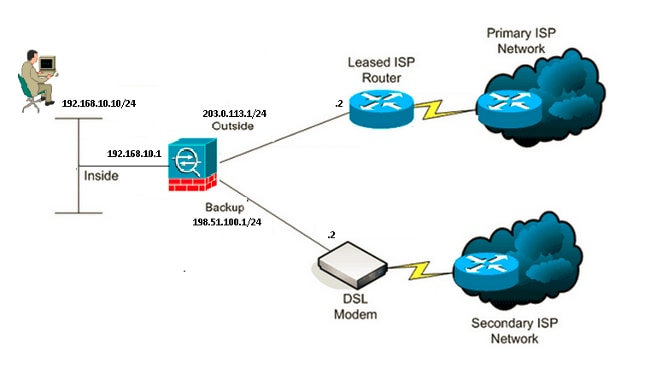
CLI Configuration
Use this information in order to configure the ASA via the CLI :
ASA# show running-config
ASA Version 9.1(5)
!
hostname ASA
!
interface GigabitEthernet0/0
nameif inside
security-level 100
ip address 192.168.10.1 255.255.255.0
!
interface GigabitEthernet0/1
nameif outside
security-level 0
ip address 203.0.113.1 255.255.255.0
!
interface GigabitEthernet0/2
nameif backup
security-level 0
ip address 198.51.100.1 255.255.255.0
!--- The interface attached to the Secondary ISP.
!--- "backup" was chosen here, but any name can be assigned.
!
interface GigabitEthernet0/3
shutdown
no nameif
no security-level
no ip address
!
interface GigabitEthernet0/4
no nameif
no security-level
no ip address
!
interface GigabitEthernet0/5
no nameif
no security-level
no ip address
!
interface Management0/0
management-only
no nameif
no security-level
no ip address
!
boot system disk0:/asa915-smp-k8.bin
ftp mode passive
clock timezone IND 5 30
object network Inside_Network
subnet 192.168.10.0 255.255.255.0
object network inside_network
subnet 192.168.10.0 255.255.255.0
pager lines 24
logging enable
mtu inside 1500
mtu outside 1500
mtu backup 1500
icmp unreachable rate-limit 1 burst-size 1
no asdm history enable
arp timeout 14400
no arp permit-nonconnected
!
object network Inside_Network
nat (inside,outside) dynamic interface
object network inside_network
nat (inside,backup) dynamic interface
!--- NAT Configuration for Outside and Backup
route outside 0.0.0.0 0.0.0.0 203.0.113.2 1 track 1
!--- Enter this command in order to track a static route.
!--- This is the static route to be installed in the routing
!--- table while the tracked object is reachable. The value after
!--- the keyword "track" is a tracking ID you specify.
route backup 0.0.0.0 0.0.0.0 198.51.100.2 254
!--- Define the backup route to use when the tracked object is unavailable.
!--- The administrative distance of the backup route must be greater than
!--- the administrative distance of the tracked route.
!--- If the primary gateway is unreachable, that route is removed
!--- and the backup route is installed in the routing table
!--- instead of the tracked route.
timeout xlate 3:00:00
timeout pat-xlate 0:00:30
timeout conn 1:00:00 half-closed 0:10:00 udp 0:02:00 icmp 0:00:02
timeout sunrpc 0:10:00 h323 0:05:00 h225 1:00:00 mgcp 0:05:00 mgcp-pat 0:05:00
timeout sip 0:30:00 sip_media 0:02:00 sip-invite 0:03:00 sip-disconnect 0:02:00
timeout sip-provisional-media 0:02:00 uauth 0:05:00 absolute
timeout tcp-proxy-reassembly 0:01:00
timeout floating-conn 0:00:00
sla monitor 123
type echo protocol ipIcmpEcho 4.2.2.2 interface outside
num-packets 3
frequency 10
!--- Configure a new monitoring process with the ID 123. Specify the
!--- monitoring protocol and the target network object whose availability the tracking
!--- process monitors. Specify the number of packets to be sent with each poll.
!--- Specify the rate at which the monitor process repeats (in seconds).
sla monitor schedule 123 life forever start-time now
!--- Schedule the monitoring process. In this case the lifetime
!--- of the process is specified to be forever. The process is scheduled to begin
!--- at the time this command is entered. As configured, this command allows the
!--- monitoring configuration specified above to determine how often the testing
!--- occurs. However, you can schedule this monitoring process to begin in the
!--- future and to only occur at specified times.
crypto ipsec security-association pmtu-aging infinite
crypto ca trustpool policy
!
track 1 rtr 123 reachability
!--- Associate a tracked static route with the SLA monitoring process.
!--- The track ID corresponds to the track ID given to the static route to monitor:
!--- route outside 0.0.0.0 0.0.0.0 10.0.0.2 1 track 1
!--- "rtr" = Response Time Reporter entry. 123 is the ID of the SLA process
!--- defined above.
telnet timeout 5
ssh stricthostkeycheck
ssh timeout 5
ssh key-exchange group dh-group1-sha1
console timeout 0
priority-queue inside
threat-detection statistics access-list
no threat-detection statistics tcp-intercept
!
class-map inspection_default
match default-inspection-traffic
!
!
policy-map type inspect dns preset_dns_map
parameters
message-length maximum client auto
message-length maximum 512
policy-map global_policy
class inspection_default
inspect dns preset_dns_map
inspect ftp
inspect h323 h225
inspect h323 ras
inspect rsh
inspect rtsp
inspect esmtp
inspect sqlnet
inspect skinny
inspect sunrpc
inspect xdmcp
inspect sip
inspect netbios
inspect tftp
inspect ip-options
inspect icmp
!
service-policy global_policy global
ASDM Configuration
Complete these steps in order to configure redundant or backup ISP support with the ASDM application:
- Within the ASDM application, click Configuration, and then click Interfaces.
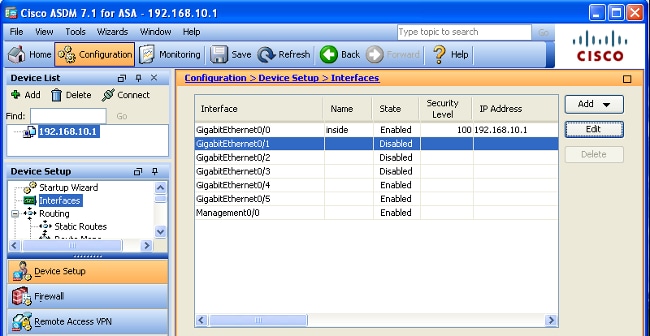
- Select GigabitEthernet0/1 from the Interfaces list, and then click Edit. This dialog box appears:
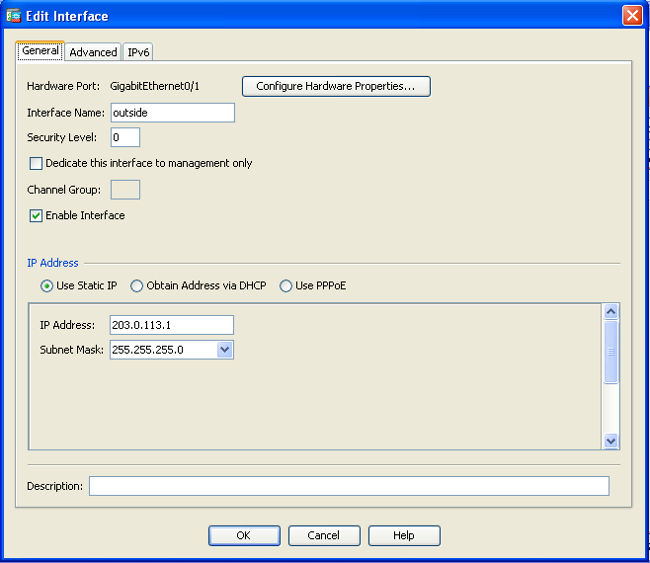
- Check the Enable Interface check box, and enter the appropriate values in the Interface Name, Security Level, IP Address, and Subnet Mask fields.
- Click OK in order to close the dialog box.
- Configure the other interfaces as needed, and then click Apply in order to update the ASA configuration:

- Select Routing and click Static Routes located on the left side of the ASDM application:

- Click Add in order to add the new static routes. This dialog box appears:
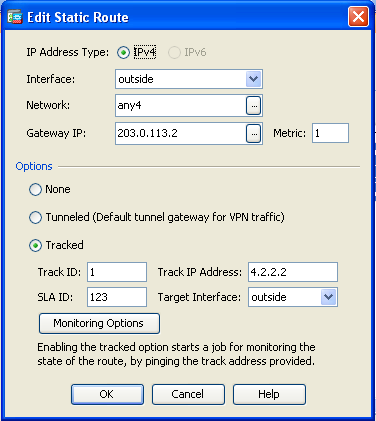
- From the Interface Name drop-down list, choose the interface on which the route resides, and configure the default route to reach the gateway. In this example, 203.0.113.2 is the primary ISP gateway and 4.2.2.2 is the object to monitor with ICMP echoes.
- In the Options area, click the Tracked radio button and enter the appropriate values in the Track ID, SLA ID, and Track IP Address fields.
- Click Monitoring Options. This dialog box appears:
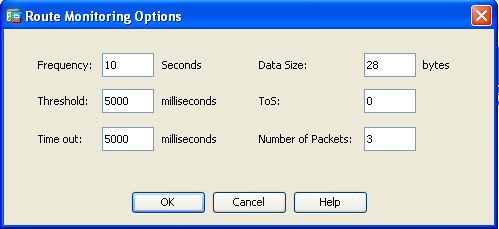
- Enter the appropriate values for the frequency and other monitoring options, and then click OK.
- Add another static route for the secondary ISP in order to provide a route to reach the Internet. In order to make it a secondary route, configure this route with a higher metric, such as 254. If the primary route (primary ISP) fails, that route is removed from the routing table. This secondary route (secondary ISP) is installed in the Private Internet Exchange (PIX) routing table instead.
- Click OK in order to close the dialog box:
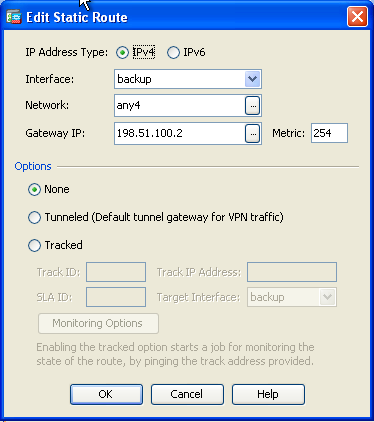
The configurations appear in the Interface list: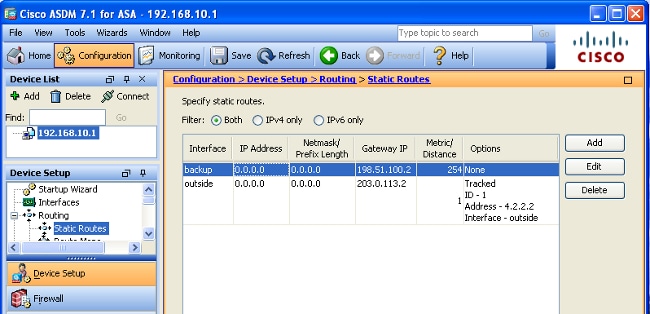
- Select the routing configuration, and then click Apply in order to update the ASA configuration.
Verify
Use this section in order to confirm that your configuration works properly.
Confirm that the Configuration is Complete
Note: The Output Interpreter Tool (registered customers only) supports certain show commands. Use the Output Interpreter Tool in order to view an analysis of show command output.
Use these show commands in order to verify that your configuration is complete:
- show running-config sla monitor – The output of this command displays the SLA commands in the configuration.
ASA# show running-config sla monitor
sla monitor 123
type echo protocol ipIcmpEcho 4.2.2.2 interface outside
num-packets 3
frequency 10
sla monitor schedule 123 life forever start-time now - show sla monitor configuration – The output of this command displays the current configuration settings of the operation.
ASA# show sla monitor configuration 123
IP SLA Monitor, Infrastructure Engine-II.
Entry number: 123
Owner:
Tag:
Type of operation to perform: echo
Target address: 4.2.2.2
Interface: outside
Number of packets: 3
Request size (ARR data portion): 28
Operation timeout (milliseconds): 5000
Type Of Service parameters: 0x0
Verify data: No
Operation frequency (seconds): 10
Next Scheduled Start Time: Start Time already passed
Group Scheduled : FALSE
Life (seconds): Forever
Entry Ageout (seconds): never
Recurring (Starting Everyday): FALSE
Status of entry (SNMP RowStatus): Active
Enhanced History: - show sla monitor operational-state – The output of this command displays the operational statistics of the SLA operation.
- Before the primary ISP fails, this is the operational state:
ASA# show sla monitor operational-state 123
Entry number: 123
Modification time: 13:30:40.672 IND Sun Jan 4 2015
Number of Octets Used by this Entry: 2056
Number of operations attempted: 46
Number of operations skipped: 0
Current seconds left in Life: Forever
Operational state of entry: Active
Last time this entry was reset: Never
Connection loss occurred: FALSE
Timeout occurred: FALSE
Over thresholds occurred: FALSE
Latest RTT (milliseconds): 1
Latest operation start time: 13:38:10.672 IND Sun Jan 4 2015
Latest operation return code: OK
RTT Values:
RTTAvg: 1 RTTMin: 1 RTTMax: 1
NumOfRTT: 3 RTTSum: 3 RTTSum2: 3 - After the primary ISP fails (and the ICMP echoes time-out), this is the operational state:
ASA# show sla monitor operational-state
Entry number: 123
Modification time: 13:30:40.671 IND Sun Jan 4 2015
Number of Octets Used by this Entry: 2056
Number of operations attempted: 57
Number of operations skipped: 0
Current seconds left in Life: Forever
Operational state of entry: Active
Last time this entry was reset: Never
Connection loss occurred: FALSE
Timeout occurred: TRUE
Over thresholds occurred: FALSE
Latest RTT (milliseconds): NoConnection/Busy/Timeout
Latest operation start time: 13:40:00.672 IND Sun Jan 4 2015
Latest operation return code: Timeout
RTT Values:
RTTAvg: 0 RTTMin: 0 RTTMax: 0
NumOfRTT: 0 RTTSum: 0 RTTSum2: 0
- Before the primary ISP fails, this is the operational state:
Confirm that the Backup Route is Installed (CLI Method)
Enter the show route command in order to confirm that the backup route is installed.
Before the primary ISP fails, the routing table appears similar to this:
ASA# show route
Codes: C - connected, S - static, I - IGRP, R - RIP, M - mobile, B - BGP
D - EIGRP, EX - EIGRP external, O - OSPF, IA - OSPF inter area
N1 - OSPF NSSA external type 1, N2 - OSPF NSSA external type 2
E1 - OSPF external type 1, E2 - OSPF external type 2, E - EGP
i - IS-IS, L1 - IS-IS level-1, L2 - IS-IS level-2, ia - IS-IS inter area
* - candidate default, U - per-user static route, o - ODR
P - periodic downloaded static route
Gateway of last resort is 203.0.113.2 to network 0.0.0.0
C 203.0.113.0 255.255.255.0 is directly connected, outside
C 192.168.10.0 255.255.255.0 is directly connected, inside
C 198.51.100.0 255.255.255.0 is directly connected, backup
S* 0.0.0.0 0.0.0.0 [1/0] via 203.0.113.2, outside
After the primary ISP fails, the static route is removed, and the backup route is installed, the routing table appears similar to this:
ASA# show route
Codes: C - connected, S - static, I - IGRP, R - RIP, M - mobile, B - BGP
D - EIGRP, EX - EIGRP external, O - OSPF, IA - OSPF inter area
N1 - OSPF NSSA external type 1, N2 - OSPF NSSA external type 2
E1 - OSPF external type 1, E2 - OSPF external type 2, E - EGP
i - IS-IS, L1 - IS-IS level-1, L2 - IS-IS level-2, ia - IS-IS inter area
* - candidate default, U - per-user static route, o - ODR
P - periodic downloaded static route
Gateway of last resort is 198.51.100.2 to network 0.0.0.0
C 203.0.113.0 255.255.255.0 is directly connected, outside
C 192.168.10.0 255.255.255.0 is directly connected, inside
C 198.51.100.0 255.255.255.0 is directly connected, backup
S* 0.0.0.0 0.0.0.0 [254/0] via 198.51.100.2, backup
Confirm that the Backup Route is Installed (ASDM Method)
In order to confirm that the backup route is installed via the ASDM, navigate to Monitoring > Routing, and then choose Routes from the Routing tree.
Before the primary ISP fails, the routing table appears similar to that shown in the next image. Note that the DEFAULT route points to 203.0.113.2 through the outside interface:
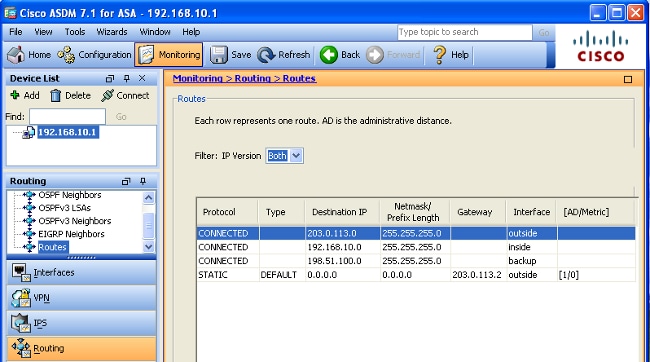
After the primary ISP fails, the route is removed and the backup route is installed. The DEFAULT route now points to 198.51.100.2 through the backup interface:
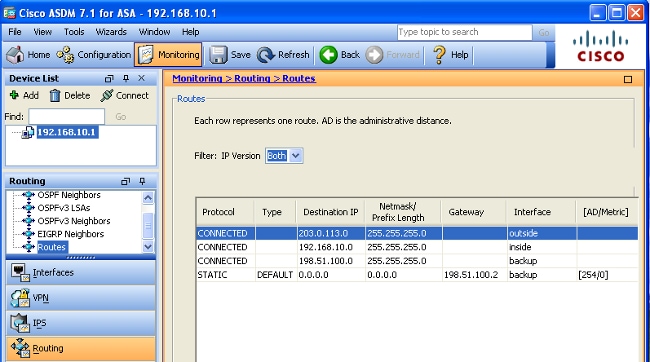
Troubleshoot
This section provides some useful debug commands and describes how to troubleshoot an issue where the tracked route is removed unnecessarily.
Debug Commands
You can use these debug commands in order to troubleshoot your configuration issues:
- debug sla monitor trace – The output of this command displays the progress of the echo operation.
- If the tracked object (primary ISP gateway) is up and the ICMP echoes succeed, the output appears similar to this:
IP SLA Monitor(123) Scheduler: Starting an operation
IP SLA Monitor(123) echo operation: Sending an echo operation
IP SLA Monitor(123) echo operation: RTT=0 OK
IP SLA Monitor(123) echo operation: RTT=0 OK
IP SLA Monitor(123) echo operation: RTT=1 OK
IP SLA Monitor(123) Scheduler: Updating result - If the tracked object (primary ISP gateway) is down and the ICMP echoes fail, the output appears similar to this:
IP SLA Monitor(123) Scheduler: Starting an operation
IP SLA Monitor(123) echo operation: Sending an echo operation
IP SLA Monitor(123) echo operation: Timeout
IP SLA Monitor(123) echo operation: Timeout
IP SLA Monitor(123) echo operation: Timeout
IP SLA Monitor(123) Scheduler: Updating result
- If the tracked object (primary ISP gateway) is up and the ICMP echoes succeed, the output appears similar to this:
- debug sla monitor error – The output of this command displays any errors that the SLA monitor process encounters.
- If the tracked object (primary ISP gateway) is up and the ICMP succeeds, the output appears similar to this:
%ASA-7-609001: Built local-host identity:203.0.113.1
%ASA-7-609001: Built local-host outside:4.2.2.2
%ASA-6-302020: Built outbound ICMP connection for faddr 4.2.2.2/0
gaddr 203.0.113.1/39878 laddr 203.0.113.1/39878
%ASA-6-302021: Teardown ICMP connection for faddr 4.2.2.2/0 gaddr
203.0.113.1/39878 laddr 203.0.113.1/39878
%ASA-7-609002: Teardown local-host identity:203.0.113.1 duration 0:00:00
%ASA-7-609002: Teardown local-host outside:4.2.2.2 duration 0:00:00
%ASA-7-609001: Built local-host identity:203.0.113.1
%ASA-7-609001: Built local-host outside:4.2.2.2
%ASA-6-302020: Built outbound ICMP connection for faddr 4.2.2.2/0
gaddr 203.0.113.1/39879 laddr 203.0.113.1/39879
%ASA-6-302021: Teardown ICMP connection for faddr 4.2.2.2/0 gaddr
203.0.113.1/39879 laddr 203.0.113.1/39879
%ASA-7-609002: Teardown local-host identity:203.0.113.1 duration 0:00:00
%ASA-7-609002: Teardown local-host outside:4.2.2.2 duration 0:00:00 - If the tracked object (primary ISP gateway) is down and the tracked route is removed, the output appears similar to this:
%ASA-7-609001: Built local-host identity:203.0.113.1
%ASA-7-609001: Built local-host outside:4.2.2.2
%ASA-6-302020: Built outbound ICMP connection for faddr 4.2.2.2/0
gaddr 203.0.113.1/59003 laddr 203.0.113.1/59003
%ASA-6-302020: Built outbound ICMP connection for faddr 4.2.2.2/0
gaddr 203.0.113.1/59004 laddr 203.0.113.1/59004
%ASA-6-302020: Built outbound ICMP connection for faddr 4.2.2.2/0
gaddr 203.0.113.1/59005 laddr 203.0.113.1/59005
%ASA-6-302021: Teardown ICMP connection for faddr 4.2.2.2/0 gaddr
203.0.113.1/59003 laddr 203.0.113.1/59003
%ASA-6-302021: Teardown ICMP connection for faddr 4.2.2.2/0 gaddr
203.0.113.1/59004 laddr 203.0.113.1/59004
%ASA-6-302021: Teardown ICMP connection for faddr 4.2.2.2/0 gaddr
203.0.113.1/59005 laddr 203.0.113.1/59005
%ASA-7-609002: Teardown local-host identity:203.0.113.1 duration 0:00:02
%ASA-7-609002: Teardown local-host outside:4.2.2.2 duration 0:00:02
%ASA-6-622001: Removing tracked route 0.0.0.0 0.0.0.0 203.0.113.2,
distance 1, table Default-IP-Routing-Table, on interface outside
!--- 4.2.2.2 is unreachable, so the route to the Primary ISP is removed.
- If the tracked object (primary ISP gateway) is up and the ICMP succeeds, the output appears similar to this:
Tracked Route is Removed Unnecessarily
If the tracked route is removed unnecessarily, ensure that your monitoring target is always available to receive echo requests.
In addition, ensure that the state of your monitoring target (that is, whether or not the target is reachable) is closely tied to the state of the primary ISP connection.
If you choose a monitoring target that is farther away than the ISP gateway, another link along that route possibly fails or another device possibly interferes.
This configuration therefore potentially causes the SLA monitor to conclude that the connection to the primary ISP has failed and cause the ASA to unnecessarily fail over to the secondary ISP link.
For example, if you choose a branch office router as your monitoring target, the ISP connection to your branch office could fail, as well as any other link along the way.
Once the ICMP echoes that are sent by the monitoring operation fail, the primary tracked route is removed, even though the primary ISP link is still active.
In this example, the primary ISP gateway that is used as the monitoring target is managed by the ISP and is located on the other side of the ISP link.
This configuration ensures that if the ICMP echoes that are sent by the monitoring operation fail, the ISP link is almost surely down.
Related Information
Revision History
| Revision | Publish Date | Comments |
|---|---|---|
3.0 |
14-Aug-2024 |
Recertification |
1.0 |
15-May-2015 |
Initial Release |
Contributed by Cisco Engineers
- Prashant JoshiTechnical Consulting Engineer
- Dinkar SharmaTechnical Consulting Engineer
Contact Cisco
- Open a Support Case

- (Requires a Cisco Service Contract)
 Feedback
Feedback